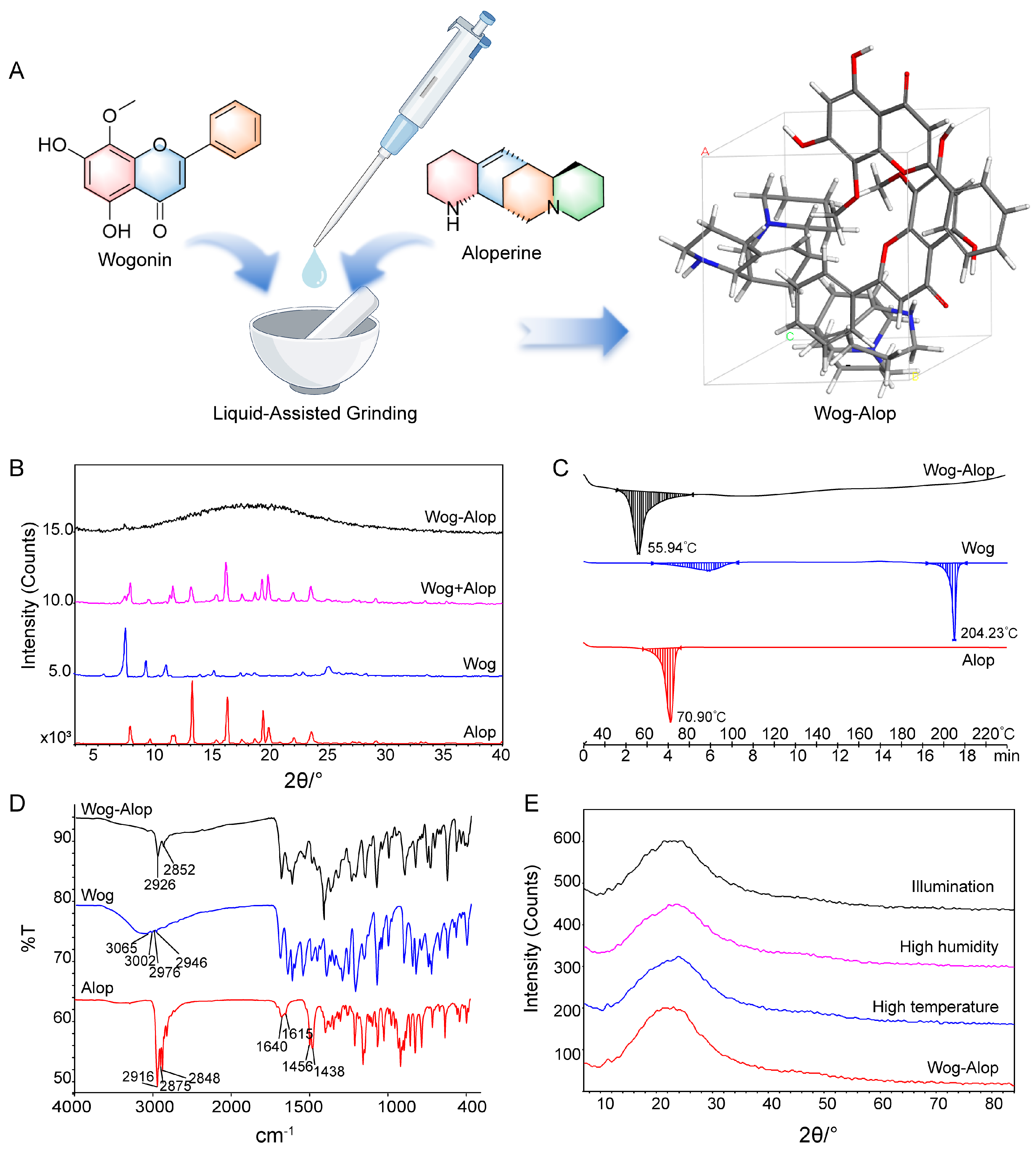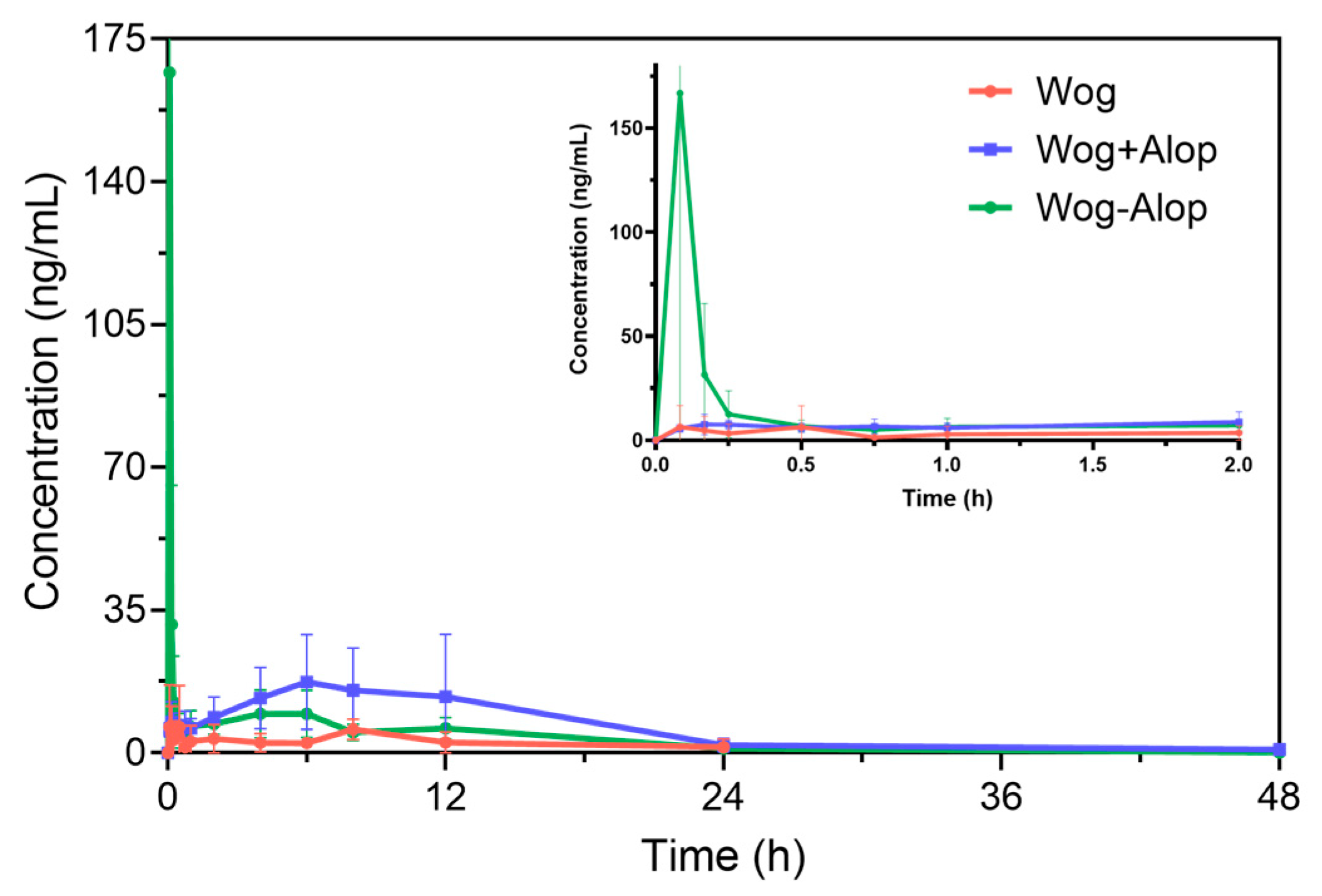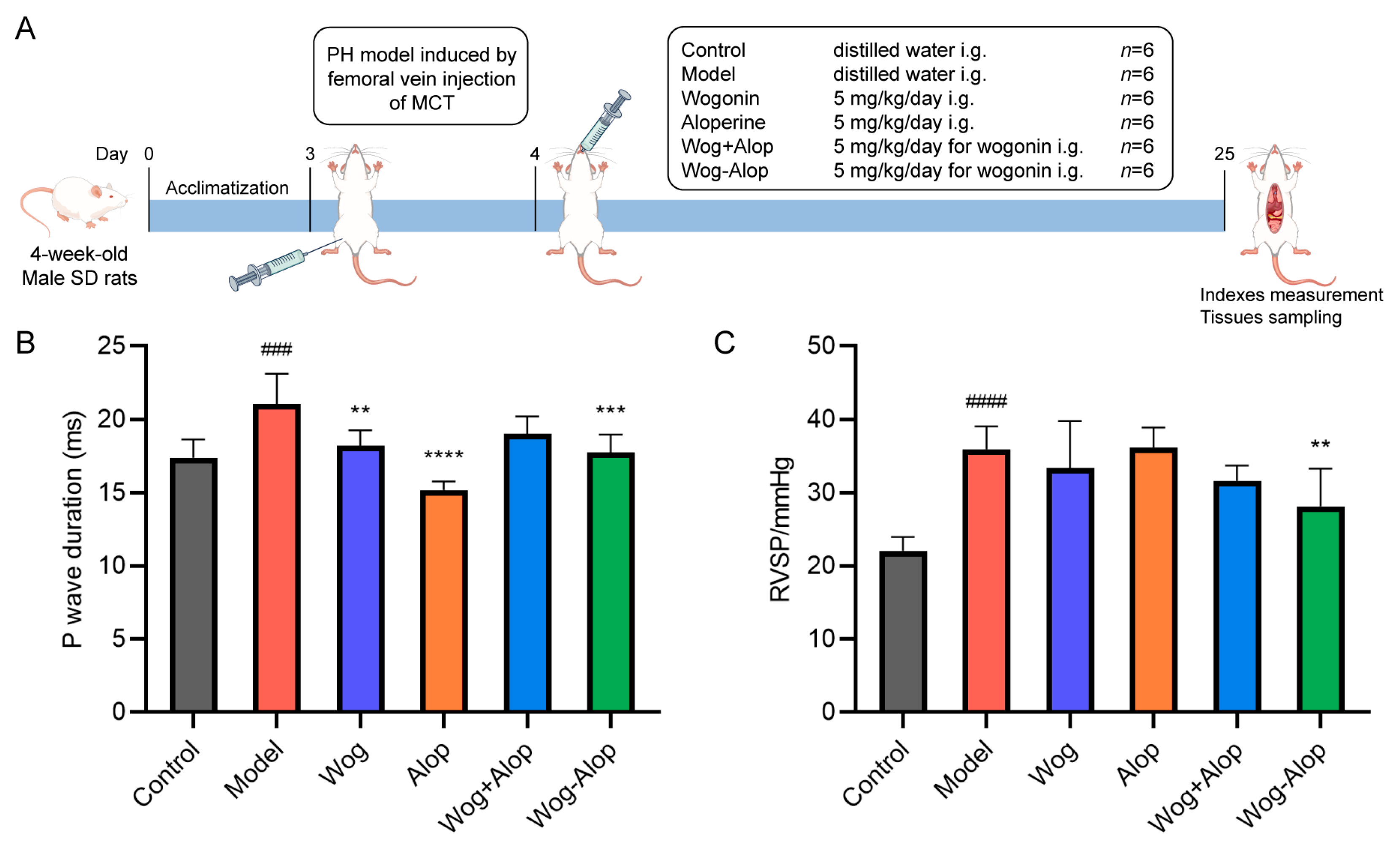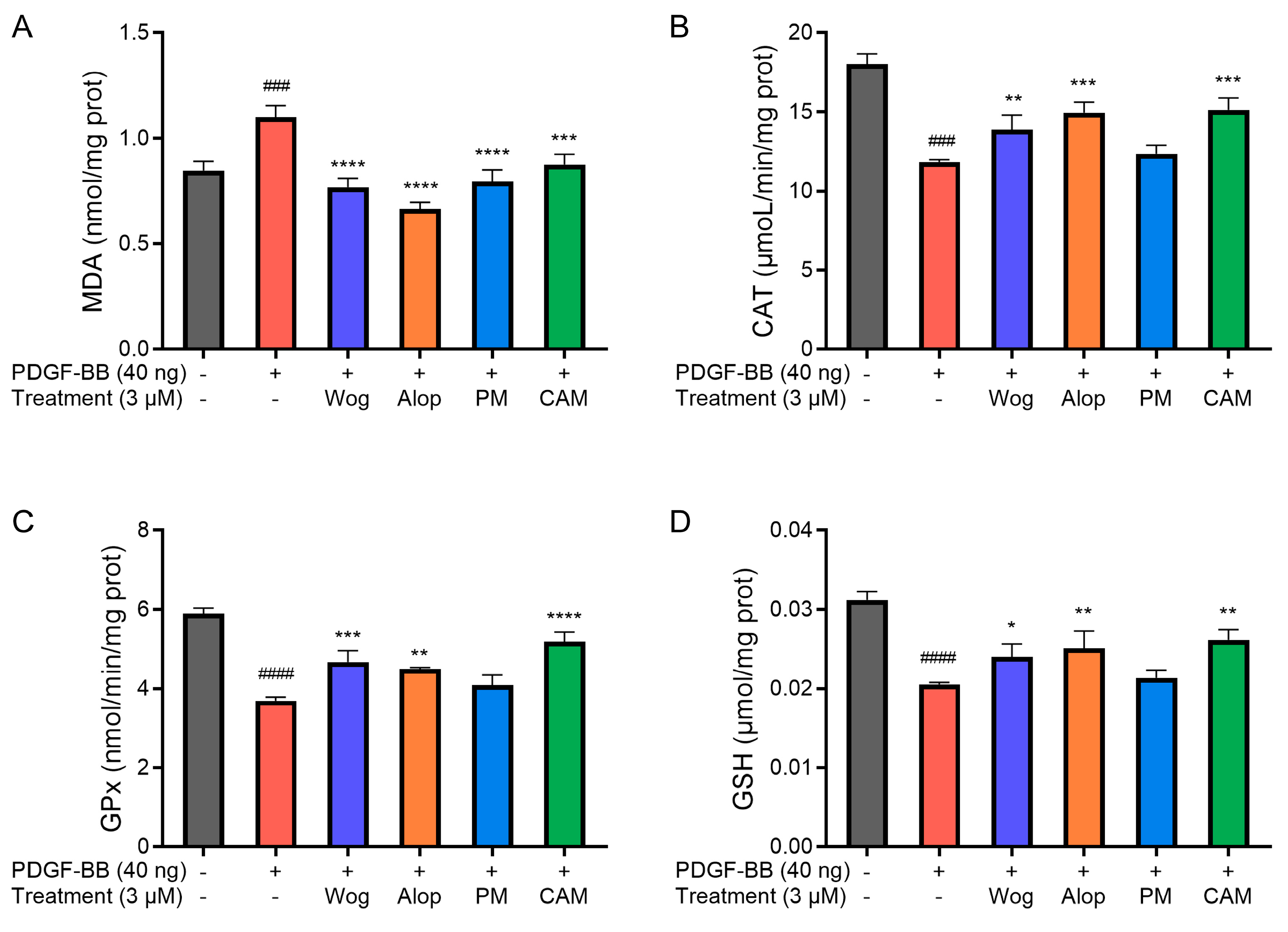Mechanistic Insight into the Enhanced Anti-Pulmonary Hypertension Efficacy of Wogonin Co-Amorphous
Abstract
1. Introduction
2. Materials and Methods
2.1. Materials and Agents
2.2. Animals
2.3. Preparation of Wogonin-Aloperine Co-Amorphous
2.4. Characterization of Wogonin-Aloperine Co-Amorphous
2.5. In Vitro Dissolution
2.6. Pharmacokinetic Studies
2.7. Anti-Pulmonary Hypertension Pharmacodynamics
2.8. Cell Culture and Treatment
2.9. Cell Viability Assay
2.10. ROS Detection
2.11. Measurement of Oxidative Stress Markers
2.12. Statistical Analysis
3. Results
3.1. Preparation and Characterization of Wog-Alop
3.2. In Vitro Dissolution and In Vivo Pharmacokinetics of Wog-Alop
3.3. In Vivo Anti-Pulmonary Hypertension Pharmacodynamics
3.3.1. Hemodynamics and Myocardial Electrophysiology
3.3.2. Right Ventricular Remodeling
3.3.3. Pulmonary Vascular Remodeling
3.4. Cell Culture and Treatment
3.5. ROS Detection
3.6. Measurement of Oxidative Stress Markers
4. Discussion
5. Conclusions
Author Contributions
Funding
Institutional Review Board Statement
Informed Consent Statement
Data Availability Statement
Acknowledgments
Conflicts of Interest
Abbreviations
| PH | Pulmonary hypertension |
| PASMCs | Pulmonary artery smooth muscle cells |
| ROS | Reactive oxygen species |
| MDA | Malondialdehyde |
| SOD | Superoxide dismutase |
| CAT | Catalase |
| Wog | Wogonin |
| Wog+Alop | The physical mixture of wogonin and aloperine |
| Wog-Alop | Wogonin-aloperine co-amorphous |
| PDGF-BB | Platelet-derived growth factor-BB |
| CAM | Co-amorphous |
| API | Active pharmaceutical ingredient |
| CCF | Co-amorphous co-former |
| PXRD | Powder X-ray diffraction |
| DSC | Differential scanning calorimetry |
| FTIR | Fourier transform infrared |
| MCT | Monocrotaline |
| UPLC | Ultra-performance liquid chromatography |
| UPLC-QQQ-MS | Ultra-performance liquid chromatography-tandem triple quadrupole mass spectrometry |
| RVSP | Right ventricular systolic pressure |
| RV | Right ventricle |
| LV | Left ventricle |
| S | Ventricular septum |
| RVHI | Right ventricular hypertrophy index |
| LMI | Lung mass index |
| PCNA | Proliferating cell nuclear antigen |
| DMEM | Dulbecco’s modified Eagle medium |
| FBS | Fetal bovine serum |
| P/S | Penicillin/streptomycin |
| CCK-8 | Cell counting kit-8 |
| DCFH-DA | 2′,7′-dichlorodihydrofluorescein diacetate |
| GSH | Glutathione |
| GPx | Glutathione peroxidase |
References
- Cueto-Robledo, G.; Tovar-Benitez, D.; Alfaro-Cruz, A.; Gonzalez-Hermosillo, L.-M. Systemic Scleroderma: Review and Updated Approach and Case Description to Addressing Pulmonary Arterial Hypertension and Idiopathic Pulmonary Fibrosis: A Dual Challenge in Treatment. Curr. Probl. Cardiol. 2024, 49, 102404. [Google Scholar] [CrossRef] [PubMed]
- Pugliese, S.C.; Poth, J.M.; Fini, M.A.; Olschewski, A.; El Kasmi, K.C.; Stenmark, K.R. The Role of Inflammation in Hypoxic Pulmonary Hypertension: From Cellular Mechanisms to Clinical Phenotypes. Am. J. Physiol. Lung Cell. Mol. Physiol. 2015, 308, L229–L252. [Google Scholar] [CrossRef]
- Chen, J.N.; Zhou, R.D.P. On the Sign-Imbalance of Permutation Tableaux. Adv. Appl. Math. 2017, 86, 1–18. [Google Scholar] [CrossRef]
- Zimmer, A.; Teixeira, R.B.; Constantin, R.L.; Campos-Carraro, C.; Aparicio Cordero, E.A.; Ortiz, V.D.; Donatti, L.; Gonzalez, E.; Bahr, A.C.; Visioli, F.; et al. The Progression of Pulmonary Arterial Hypertension Induced by Monocrotaline Is Characterized by Lung Nitrosative and Oxidative Stress, and Impaired Pulmonary Artery Reactivity. Eur. J. Pharmacol. 2021, 891, 173699. [Google Scholar] [CrossRef] [PubMed]
- Yu, W.; Chen, H.; Yang, H.; Xia, P.; Zou, C.; Sun, T.; Wang, L. rBMSC/Cav-1F92A Mediates Oxidative Stress in PAH Rat by Regulating SelW/14-3-3η and CA1/Kininogen Signal Transduction. Stem Cells Int. 2019, 2019, 6768571. [Google Scholar] [CrossRef]
- Xue, C.; Senchanthisai, S.; Sowden, M.; Pang, J.; White, R.J.; Berk, B.C. Endothelial-to-Mesenchymal Transition and Inflammation Play Key Roles in Cyclophilin A–Induced Pulmonary Arterial Hypertension. Hypertension 2020, 76, 1113–1123. [Google Scholar] [CrossRef] [PubMed]
- Wang, E.-L.; Jia, M.-M.; Luo, F.-M.; Li, T.; Peng, J.-J.; Luo, X.-J.; Song, F.-L.; Yang, J.-F.; Peng, J.; Liu, B. Coordination between NADPH Oxidase and Vascular Peroxidase 1 Promotes Dysfunctions of Endothelial Progenitor Cells in Hypoxia-Induced Pulmonary Hypertensive Rats. Eur. J. Pharmacol. 2019, 857, 172459. [Google Scholar] [CrossRef]
- Ochoa, C.D.; Wu, R.F.; Terada, L.S. ROS Signaling and ER Stress in Cardiovascular Disease. Mol. Asp. Med. 2018, 63, 18–29. [Google Scholar] [CrossRef]
- Kikuchi, N.; Satoh, K.; Kurosawa, R.; Yaoita, N.; Elias-Al-Mamun, M.; Siddique, M.A.H.; Omura, J.; Satoh, T.; Nogi, M.; Sunamura, S.; et al. Selenoprotein P Promotes the Development of Pulmonary Arterial Hypertension. Circulation 2018, 138, 600–623. [Google Scholar] [CrossRef]
- Shults, N.V.; Melnyk, O.; Suzuki, D.I.; Suzuki, Y.J. Redox Biology of Right-Sided Heart Failure. Antioxidants 2018, 7, 106. [Google Scholar] [CrossRef]
- Wang, D.; Li, H.; Weir, E.K.; Xu, Y.; Xu, D.; Chen, Y. Dimethylarginine Dimethylaminohydrolase 1 Deficiency Aggravates Monocrotaline-Induced Pulmonary Oxidative Stress, Pulmonary Arterial Hypertension and Right Heart Failure in Rats. Int. J. Cardiol. 2019, 295, 14–20. [Google Scholar] [CrossRef] [PubMed]
- Hu, L.; Zhao, C.; Chen, Z.; Hu, G.; Li, X.; Li, Q. An Emerging Strategy for Targeted Therapy of Pulmonary Arterial Hypertension: Vasodilation plus Vascular Remodeling Inhibition. Drug Discov. Today 2022, 27, 1457–1463. [Google Scholar] [CrossRef] [PubMed]
- Shi, X.; Zhang, B.; Chu, Z.; Han, B.; Zhang, X.; Huang, P.; Han, J. Wogonin Inhibits Cardiac Hypertrophy by Activating Nrf-2-Mediated Antioxidant Responses. Cardiovasc. Ther. 2021, 2021, 9995342. [Google Scholar] [CrossRef]
- Qu, J.-T.; Zhang, D.-X.; Liu, F.; Mao, H.-P.; Ma, Y.-K.; Yang, Y.; Li, C.-X.; Qiu, L.-Z.; Geng, X.; Zhang, J.-M.; et al. Vasodilatory Effect of Wogonin on the Rat Aorta and Its Mechanism Study. Biol. Pharm. Bull. 2015, 38, 1873–1878. [Google Scholar] [CrossRef]
- Lu, L.; Li, Y.; Dong, Q.; Fang, J.; Chen, A.; Lan, Z.; Ye, Y.; Yan, J.; Liang, Q. Wogonin Inhibits Oxidative Stress and Vascular Calcification via Modulation of Heme Oxygenase-1. Eur. J. Pharmacol. 2023, 958, 176070. [Google Scholar] [CrossRef] [PubMed]
- Bian, B.; Ge, C.; Wu, F.; Fan, Y.; Kong, J.; Li, K.; Bian, H.; Miao, Q. Wogonin Attenuates Bleomycin-Induced Pulmonary Fibrosis and Oxidative Stress Injury via the MAPK Signaling Pathway. Biol. Pharm. Bull. 2024, 47, 2165–2172. [Google Scholar] [CrossRef]
- He, X.; Wang, J.; Sun, L.; Ma, W.; Li, M.; Yu, S.; Zhou, Q.; Jiang, J. Wogonin Attenuates Inflammation and Oxidative Stress in Lipopolysaccharide-Induced Mastitis by Inhibiting Akt/NF-κB Pathway and Activating the Nrf2/HO-1 Signaling. Cell Stress Chaperones 2023, 28, 989–999. [Google Scholar] [CrossRef]
- Cui, L.; Zeng, Z.; Wang, X.; Yuan, T.; Wang, C.; Liu, D.; Guo, J.; Chen, Y. Deciphering the Mechanism of Wogonin, a Natural Flavonoid, on the Proliferation of Pulmonary Arterial Smooth Muscle Cells by Integrating Network Pharmacology and In Vitro Validation. Curr. Issues Mol. Biol. 2023, 45, 555–570. [Google Scholar] [CrossRef]
- Talbi, A.; Zhao, D.; Liu, Q.; Li, J.; Fan, A.; Yang, W.; Han, X.; Chen, X. Pharmacokinetics, Tissue Distribution, Excretion and Plasma Protein Binding Studies of Wogonin in Rats. Molecules 2014, 19, 5538–5549. [Google Scholar] [CrossRef]
- Zhu, N.; Li, J.; Zhu, J.; Wang, X.; Zhang, J. Characterization and Bioavailability of Wogonin by Different Administration Routes in Beagles. Med. Sci. Monit. 2016, 22, 3737–3745. [Google Scholar] [CrossRef]
- Tao, L.; Fu, R.; Wang, X.; Yao, J.; Zhou, Y.; Dai, Q.; Li, Z.; Lu, N.; Wang, W. LL-202, a Newly Synthesized Flavonoid, Inhibits Tumor Growth via Inducing G(2)/M Phase Arrest and Cell Apoptosis in MCF-7 Human Breast Cancer Cells in Vitro and in Vivo. Toxicol. Lett. 2014, 228, 1–12. [Google Scholar] [CrossRef]
- Sun, J.; Li, F.; Zhao, Y.; Zhao, L.; Qiao, C.; Li, Z.; Guo, Q.; Lu, N. LZ-207, a Newly Synthesized Flavonoid, Induces Apoptosis and Suppresses Inflammation-Related Colon Cancer by Inhibiting the NF-κB Signaling Pathway. PLoS ONE 2015, 10, e0127282. [Google Scholar] [CrossRef] [PubMed]
- Wu, H.; Ren, J.; Zhao, L.; Li, Z.; Ye, W.; Yang, Y.; Wang, J.; Bian, J. Identification of Novel Androgen Receptor Degrading Agents to Treat Advanced Prostate Cancer. Eur. J. Med. Chem. 2021, 217, 113376. [Google Scholar] [CrossRef] [PubMed]
- Bian, J.; Li, T.; Weng, T.; Wang, J.; Chen, Y.; Li, Z. Synthesis, Evaluation and Quantitative Structure-Activity Relationship (QSAR) Analysis of Wogonin Derivatives as Cytotoxic Agents. Bioorg Med. Chem. Lett. 2017, 27, 1012–1016. [Google Scholar] [CrossRef]
- Baek, J.-S.; Na, Y.-G.; Cho, C.-W. Sustained Cytotoxicity of Wogonin on Breast Cancer Cells by Encapsulation in Solid Lipid Nanoparticles. Nanomaterials 2018, 8, 159. [Google Scholar] [CrossRef] [PubMed]
- Sabra, S.A.; Elzoghby, A.O.; Sheweita, S.A.; Haroun, M.; Helmy, M.W.; Eldemellawy, M.A.; Xia, Y.; Goodale, D.; Allan, A.L.; Rohani, S. Self-Assembled Amphiphilic Zein-Lactoferrin Micelles for Tumor Targeted Co-Delivery of Rapamycin and Wogonin to Breast Cancer. Eur. J. Pharm. Biopharm. 2018, 128, 156–169. [Google Scholar] [CrossRef]
- Yang, B.; Dong, Y.; Xu, Z.; Li, X.; Wang, F.; Zhang, Y. Improved Stability and Pharmacokinetics of Wogonin through Loading into PASylated Ferritin. Colloids Surf. B Biointerfaces 2022, 216, 112515. [Google Scholar] [CrossRef]
- Dengale, S.J.; Grohganz, H.; Rades, T.; Löbmann, K. Recent Advances in Co-Amorphous Drug Formulations. Adv. Drug Deliv. Rev. 2016, 100, 116–125. [Google Scholar] [CrossRef]
- Wang, H.; Yang, D.; Zhang, W.; Song, J.; Gong, N.; Yu, M.; Yang, S.; Zhang, B.; Liu, Q.; Du, G.; et al. An Innovative Rhein-Matrine Cocrystal: Synthesis, Characterization, Formation Mechanism and Pharmacokinetic Study. Chin. Chem. Lett. 2023, 34, 107258. [Google Scholar] [CrossRef]
- Yang, D.; Wang, H.; Liu, Q.; Yuan, P.; Chen, T.; Zhang, L.; Yang, S.; Zhou, Z.; Lu, Y.; Du, G. Structural Landscape on a Series of Rhein: Berberine Cocrystal Salt Solvates: The Formation, Dissolution Elucidation from Experimental and Theoretical Investigations. Chin. Chem. Lett. 2022, 33, 3207–3211. [Google Scholar] [CrossRef]
- Wang, Y.; Yan, B.; Ma, P.; Zhou, R.; Zhao, F. Mechanism of Action of Aloperine in the Treatment of Pulmonary Arterial Hypertension Based on Network Pharmacology and Molecular Docking Methods. Herz 2025. [Google Scholar] [CrossRef] [PubMed]
- Shan, X.; Gegentuya; Wang, J.; Feng, H.; Zhang, Z.; Zheng, Q.; Zhang, Q.; Yang, K.; Wang, J.; Xu, L. Aloperine Protects Pulmonary Hypertension via Triggering PPARγ Signaling and Inhibiting Calcium Regulatory Pathway in Pulmonary Arterial Smooth Muscle Cells. Am. J. Physiol. Cell Physiol. 2023, 325, C1058–C1072. [Google Scholar] [CrossRef]
- Liu, H.; Liu, S.; Ma, P.; Ma, L.; Liu, Y.; Zhao, F.; Zhou, R. Development and Evaluation of Aloperine-Loaded Nanostructured Lipid Carriers for the Treatment of Pulmonary Arterial Hypertension. Int. J. Nanomed. 2025, 20, 871–886. [Google Scholar] [CrossRef]
- Karagianni, A.; Kachrimanis, K.; Nikolakakis, I. Co-Amorphous Solid Dispersions for Solubility and Absorption Improvement of Drugs: Composition, Preparation, Characterization and Formulations for Oral Delivery. Pharmaceutics 2018, 10, 98. [Google Scholar] [CrossRef]
- Rode, K.; Maji, I.; Mahajan, S.; Singh, P.K. Unlocking the Potential of Flavonoid-Based Co-Crystal and Co-Amorphous Systems. Drug Discov. Today 2024, 29, 104050. [Google Scholar] [CrossRef]
- Grohganz, H.; Löbmann, K.; Priemel, P.; Tarp Jensen, K.; Graeser, K.; Strachan, C.; Rades, T. Amorphous Drugs and Dosage Forms. J. Drug Deliv. Sci. Technol. 2013, 23, 403–408. [Google Scholar] [CrossRef]
- Bavishi, D.D.; Borkhataria, C.H. Spring and Parachute: How Cocrystals Enhance Solubility. Prog. Cryst. Growth Charact. Mater. 2016, 62, 1–8. [Google Scholar] [CrossRef]
- Wei, Y.; Zhang, L.; Wang, N.; Shen, P.; Dou, H.; Ma, K.; Gao, Y.; Zhang, J.; Qian, S. Mechanistic Study on Complexation-Induced Spring and Hover Dissolution Behavior of Ibuprofen-Nicotinamide Cocrystal. Cryst. Growth Des. 2018, 18, 7343–7355. [Google Scholar] [CrossRef]
- Childs, S.L.; Kandi, P.; Lingireddy, S.R. Formulation of a Danazol Cocrystal with Controlled Supersaturation Plays an Essential Role in Improving Bioavailability. Mol. Pharm. 2013, 10, 3112–3127. [Google Scholar] [CrossRef]
- Ruffenach, G.; Hong, J.; Vaillancourt, M.; Medzikovic, L.; Eghbali, M. Pulmonary Hypertension Secondary to Pulmonary Fibrosis: Clinical Data, Histopathology and Molecular Insights. Respir. Res. 2020, 21, 303. [Google Scholar] [CrossRef]
- Poyatos, P.; Gratacós, M.; Samuel, K.; Orriols, R.; Tura-Ceide, O. Oxidative Stress and Antioxidant Therapy in Pulmonary Hypertension. Antioxidants 2023, 12, 1006. [Google Scholar] [CrossRef] [PubMed]
- Zhang, G.; Guan, H.; Li, J.; Li, M.; Sui, X.; Tian, B.; Dong, H.; Liu, B.; He, Z.; Li, N.; et al. Roles of Effective Stabilizers in Improving Oral Bioavailability of Naringenin Nanocrystals: Maintenance of Supersaturation Generated upon Dissolution by Inhibition of Drug Dimerization. Asian J. Pharm. Sci. 2022, 17, 741–750. [Google Scholar] [CrossRef] [PubMed]
- Wang, H.; Zhao, P.; Ma, R.; Jia, J.; Fu, Q. Drug–Drug Co-Amorphous Systems: An Emerging Formulation Strategy for Poorly Water-Soluble Drugs. Drug Discov. Today 2024, 29, 103883. [Google Scholar] [CrossRef] [PubMed]









| Parameter | Wogonin | Wog+Alop | Wog-Alop |
|---|---|---|---|
| AUC(0–t) (ng·h/mL) | 49.119 ± 42.102 | 142.467 ± 70.458 ** | 133.233 ± 41.228 ** |
| AUC(0–∞) (ng·h/mL) | 76.999 ± 80.556 | 148.573 ± 67.134 * | 168.384 ± 61.471 * |
| MRT(0–t) (h) | 5.968 ± 4.792 | 7.491 ± 2.079 | 6.265 ± 2.336 |
| MRT(0–∞) (h) | 12.502 ± 17.461 | 11.341 ± 5.585 | 11.363 ± 9.549 |
| t1/2z (h) | 7.212 ± 9.973 | 4.078 ± 2.226 | 7.317 ± 6.772 |
| Tmax (h) | 1.933 ± 3.412 | 3.783 ± 3.355 | 0.083 ± 0 |
| Cmax (ng/mL) | 14.757 ± 12.221 | 18.393 ± 8.135 | 262.933 ± 159.257 **** |
| RB (%) | - | 192.954 | 218.683 |
Disclaimer/Publisher’s Note: The statements, opinions and data contained in all publications are solely those of the individual author(s) and contributor(s) and not of MDPI and/or the editor(s). MDPI and/or the editor(s) disclaim responsibility for any injury to people or property resulting from any ideas, methods, instructions or products referred to in the content. |
© 2025 by the authors. Licensee MDPI, Basel, Switzerland. This article is an open access article distributed under the terms and conditions of the Creative Commons Attribution (CC BY) license (https://creativecommons.org/licenses/by/4.0/).
Share and Cite
Xie, Z.; Chen, Y.; Xie, J.; Lei, Y.; Jia, C.; Liang, Y.; Wang, H.; Huang, J. Mechanistic Insight into the Enhanced Anti-Pulmonary Hypertension Efficacy of Wogonin Co-Amorphous. Pharmaceutics 2025, 17, 724. https://doi.org/10.3390/pharmaceutics17060724
Xie Z, Chen Y, Xie J, Lei Y, Jia C, Liang Y, Wang H, Huang J. Mechanistic Insight into the Enhanced Anti-Pulmonary Hypertension Efficacy of Wogonin Co-Amorphous. Pharmaceutics. 2025; 17(6):724. https://doi.org/10.3390/pharmaceutics17060724
Chicago/Turabian StyleXie, Zhongshui, Yucai Chen, Jiaqi Xie, Yan Lei, Chunxue Jia, Yulu Liang, Hongjuan Wang, and Jianmei Huang. 2025. "Mechanistic Insight into the Enhanced Anti-Pulmonary Hypertension Efficacy of Wogonin Co-Amorphous" Pharmaceutics 17, no. 6: 724. https://doi.org/10.3390/pharmaceutics17060724
APA StyleXie, Z., Chen, Y., Xie, J., Lei, Y., Jia, C., Liang, Y., Wang, H., & Huang, J. (2025). Mechanistic Insight into the Enhanced Anti-Pulmonary Hypertension Efficacy of Wogonin Co-Amorphous. Pharmaceutics, 17(6), 724. https://doi.org/10.3390/pharmaceutics17060724






